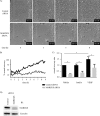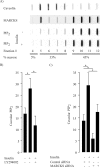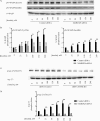The MARCKS protein plays a critical role in phosphatidylinositol 4,5-bisphosphate metabolism and directed cell movement in vascular endothelial cells
- PMID: 21097841
- PMCID: PMC3023526
- DOI: 10.1074/jbc.M110.196022
The MARCKS protein plays a critical role in phosphatidylinositol 4,5-bisphosphate metabolism and directed cell movement in vascular endothelial cells
Abstract
The MARCKS protein (myristoylated alanine-rich C kinase substrate) is an actin- and calmodulin-binding protein that is expressed in many mammalian tissues. The role of MARCKS in endothelial signaling responses is incompletely understood. We found that siRNA-mediated knockdown of MARCKS in cultured endothelial cells abrogated directed cell movement in a wound healing assay. We used biochemical and cell imaging approaches to explore the role of MARCKS in endothelial signal transduction pathways activated by insulin. Insulin treatment of vascular endothelial cells promoted the dose- and time-dependent phosphorylation of MARCKS. Cell imaging and hydrodynamic approaches revealed that MARCKS is targeted to plasmalemmal caveolae and undergoes subcellular translocation in response to insulin. Insulin treatment promoted an increase in levels of the signaling phospholipid phosphatidylinositol 4,5-bisphosphate (PIP(2)) in plasmalemmal caveolae. The insulin-stimulated increase in caveolar PIP(2) was blocked by siRNA-mediated knockdown of MARCKS, as determined using both biochemical assays and imaging studies using FRET-based PIP(2) biosensors. The critical role of PIP(2) in MARCKS responses was explored by examining the PIP(2)- and actin-binding proteins Arp2/3 and N-WASP. Insulin promoted the rapid and robust phosphorylation of both N-WASP and Arp2/3, but these phosphorylation responses were markedly attenuated by siRNA-mediated MARCKS knockdown. Moreover, MARCKS knockdown effectively abrogated N-WASP activation in response to insulin, as determined using a FRET-based N-WASP activity biosensor. Taken together, these studies show that MARCKS plays a key role in insulin-dependent endothelial signaling to PIP(2) and is a critical determinant of actin assembly and directed cell movement in the vascular endothelium.
Figures









Similar articles
-
Angiotensin-II and MARCKS: a hydrogen peroxide- and RAC1-dependent signaling pathway in vascular endothelium.J Biol Chem. 2012 Aug 17;287(34):29147-58. doi: 10.1074/jbc.M112.381517. Epub 2012 Jul 6. J Biol Chem. 2012. PMID: 22773836 Free PMC article.
-
Myristoylated Alanine-Rich Protein Kinase Substrate (MARCKS) Regulates Small GTPase Rac1 and Cdc42 Activity and Is a Critical Mediator of Vascular Smooth Muscle Cell Migration in Intimal Hyperplasia Formation.J Am Heart Assoc. 2015 Oct 8;4(10):e002255. doi: 10.1161/JAHA.115.002255. J Am Heart Assoc. 2015. PMID: 26450120 Free PMC article.
-
Functional involvement of protein kinase C-betaII and its substrate, myristoylated alanine-rich C-kinase substrate (MARCKS), in insulin-stimulated glucose transport in L6 rat skeletal muscle cells.Diabetologia. 2009 May;52(5):901-11. doi: 10.1007/s00125-009-1298-7. Epub 2009 Feb 28. Diabetologia. 2009. PMID: 19252893 Free PMC article.
-
Thrombin-induced phosphorylation of MARCKS does not alter its interactions with calmodulin or actin.Cell Signal. 2000 Feb;12(2):71-9. doi: 10.1016/s0898-6568(99)00065-0. Cell Signal. 2000. PMID: 10679575 Review.
-
The MARCKS family of phospholipid binding proteins: regulation of phospholipase D and other cellular components.Biochem Cell Biol. 2004 Feb;82(1):191-200. doi: 10.1139/o03-087. Biochem Cell Biol. 2004. PMID: 15052337 Review.
Cited by
-
Lipocalin-type prostaglandin D2 synthase protein regulates glial cell migration and morphology through myristoylated alanine-rich C-kinase substrate: prostaglandin D2-independent effects.J Biol Chem. 2012 Mar 16;287(12):9414-28. doi: 10.1074/jbc.M111.330662. Epub 2012 Jan 24. J Biol Chem. 2012. PMID: 22275363 Free PMC article.
-
Targeting N-Myristoylation Through NMT2 Prevents Cardiac Hypertrophy and Heart Failure.JACC Basic Transl Sci. 2023 Sep 6;8(10):1263-1282. doi: 10.1016/j.jacbts.2023.06.006. eCollection 2023 Oct. JACC Basic Transl Sci. 2023. PMID: 38094695 Free PMC article.
-
The MARCKS protein amount is differently regulated by calpain during toxic effects of methylmercury between SH-SY5Y and EA.hy926 cells.J Vet Med Sci. 2017 Dec 6;79(12):1931-1938. doi: 10.1292/jvms.17-0473. Epub 2017 Oct 18. J Vet Med Sci. 2017. PMID: 29046508 Free PMC article.
-
A peptide that inhibits function of Myristoylated Alanine-Rich C Kinase Substrate (MARCKS) reduces lung cancer metastasis.Oncogene. 2014 Jul 10;33(28):3696-706. doi: 10.1038/onc.2013.336. Epub 2013 Aug 19. Oncogene. 2014. PMID: 23955080 Free PMC article.
-
Targeting myristoylated alanine-rich C kinase substrate phosphorylation site domain in lung cancer. Mechanisms and therapeutic implications.Am J Respir Crit Care Med. 2014 Nov 15;190(10):1127-38. doi: 10.1164/rccm.201408-1505OC. Am J Respir Crit Care Med. 2014. PMID: 25318062 Free PMC article.
References
Publication types
MeSH terms
Substances
Grants and funding
LinkOut - more resources
Full Text Sources
Other Literature Sources
Medical
Molecular Biology Databases
Miscellaneous

